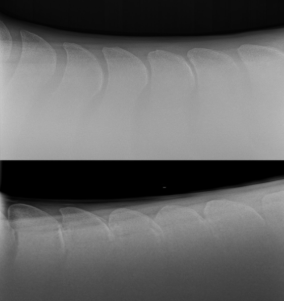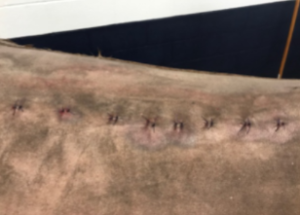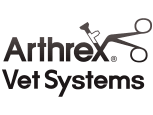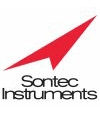Overriding/impinging dorsal spinous processes, or kissing spines, occur when a portion of the vertebrae sit too close together or are in contact with each other. This close contact can result in bony changes of the vertebrae and chronic inflammation. Most often this disorder is diagnosed in teenage horses, however radiographic changes can be identified in younger and older horses as well. Horses of any breed can be affected, but thoroughbreds and warmblood-type breeds tend to be overrepresented. The cause of kissing spines is unknown, however training, muscle strength, saddle fit, and genetic factors are all hypothesized, and most likely there are a variety of factors at play in its development. The most common vertebrae affected are through the middle to end of the thoracic spine, under where a saddle sits; however, they can occur further forward or back as well.
The clinical signs associated with kissing spines are highly variable, ranging from asymptomatic radiographic changes to a horse who is unrideable or uncomfortable with even light pressure over the affected areas. Some of the more common signs in horses who are symptomatic include bucking or head tossing under saddle, difficulty maintaining or changes in their canter, or refusing or rushing fences. Horses may be described as having generally poor performance or feeling off. Lameness can incite or exacerbate back pain and may be the presenting complaint. Horses may be sensitive to palpation or have poor muscling through their back as well.

The vague and varied clinical signs of kissing spines can make diagnosis difficult. A full lameness evaluation is typically performed both due to the variety of clinical signs as well as the frequent incidence of lameness along with back pain. Palpation of the spine and surrounding musculature can give your veterinarian an indication of whether your horse is painful, as well as the general mobility through their spine. Initial diagnostics on the farm may include radiographs (x-rays) (Figure 1), ultrasound, and/or local anesthesia of suspected painful sites within the back. For difficult cases, nuclear scintigraphy (bone scan) may be recommended to see if the affected sections through the back are showing active bony remodeling, which would light up on the imaging. Evidence of radiographic abnormalities needs to be evaluated with the whole clinical picture, considering that many horses can have radiographic changes without clinical signs of back pain, and lameness can exacerbate back pain.
Treatment is often multimodal and is heavily reliant on maintaining patient care at home. Some of the treatment options include:
- Stretching and strengthening the muscles of the back and core – A combination of stretching of spasmodic back muscles and strengthening of back and core muscles is pivotal to long term maintenance of horses with kissing spines. This will help reduce pain associated with muscle spasm and give the vertebral column the muscle support needed. There are some excellent resources available with simple exercises that can be performed in the barn to help with back and core strengthening and stretching.
- Acupuncture and chiropractor – These alternative therapies can be highly beneficial in some cases. Both can help manage pain and improve mobility in horses with kissing spines, but should be used with recommendation by your veterinarian.
- Interspinous ligament desmotomy: this procedure involves transecting the ligament which connects the adjacent vertebrae and can be performed in the standing sedated horse. There are several theories behind why this surgery helps horses with kissing spines. One is that by cutting the ligament it allows the vertebrae to move apart from each other, reducing the impingement. Additionally there are nerves which run through these ligaments and within the bone surface where the ligaments attach, so by cutting the ligament the nerves are cut as well, thereby reducing pain fibers in the area. Around 85-90% of horses improve following surgery, but a small subset of these horses will develop clinical signs again months to years after surgery. However the surgery is minimally invasive and generally well tolerated (Figure 2).
- Dorsal spinous process ostectomy: this procedure involves cutting a wedge out of adjacent vertebrae to remove the impinging bone. This surgery is more invasive than the interspinous ligament desmotomy, but can also be performed in the standing sedated horse. Some horses with more severe impingement may require this more involved procedure. Overall success is similar to the interspinous ligament desmotomy.
- Muscle relaxants – oral muscle relaxants (methocarbamol, dantrolene) can be helpful in reducing some of the acute muscle spasm which can occur with kissing spines. They may be useful particularly early in therapy to help reduce muscle spasm, followed by stretching and strengthening after the initial muscle relaxation.
- Local injections – There are a variety of therapies which can be administered by injection. Mesotherapy is a series of injections just under the skin which are thought to help “turn off” some of the pain pathways traveling up the spinal cord. Additionally local injection of anti-inflammatories (often steroids) can be used directly around the affected vertebrae or within the ligament connecting the vertebrae to help contribute to pain relief locally.
- Surgical treatment options: 2 options for surgical intervention are possible depending on the patient, disease severity, and surgeon preferences.

Regardless of the treatment plan selected by the veterinarian and owner, continued rehabilitation at home is key to long-term success in managing horses with kissing spines. Maintaining strong musculature and spinal flexibility will be key to long-term treatment success. Overall prognosis is excellent with appropriate therapy and rehabilitation, with 80-90% of horses returning to some degree of performance. A full lameness evaluation is key, as back pain can be initiated or exacerbated by lameness; treatment of primary lameness will be pivotal to improving the kissing spine pain in these cases.













